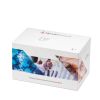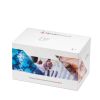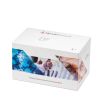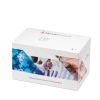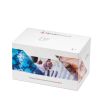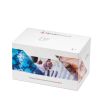Transgelin, Human, Assay – 2 x 96 det. - HK398-02
Catalog #
HK398-02
1.223,00 €
Transgelin, also known as SM22, is a cytoskeletal protein prominently expressed in smooth muscle cells, including those found in the gastrointestinal tract. Its primary function is associated with the regulation of actin dynamics. It contributes to the structural integrity and contractility of smooth muscle tissues.
In the context of gut health, the detection of transgelin can serve as a valuable biomarker for assessing gut damage and related pathological conditions. As a marker, it stands out in the detection of acute intestinal ischemia (AII). AII is a severe abdominal emergency with a high risk of morbidity and mortality. It results from mesenteric blood flow disruption associated with surgical procedures, hemorrhagic shock, trauma, and sepsis. This condition can cause severe damage to intestinal integrity, leading to the release of muscle cell proteins like transgelin. In oncology, transgelin proves valuable for diagnosing leiomyosarcoma.
The Transgelin ELISA kit provides a non-invasive method to assess the severity of gut damage caused by acute intestinal ischemia. It specifically detects disruptions in smooth muscle cells. When combined with I-FABP, a biomarker for epithelial gut damage, this kit offers an effective way to localize and evaluate intestinal injury. It eliminates the need for invasive procedures such as colonoscopy.
In the context of gut health, the detection of transgelin can serve as a valuable biomarker for assessing gut damage and related pathological conditions. As a marker, it stands out in the detection of acute intestinal ischemia (AII). AII is a severe abdominal emergency with a high risk of morbidity and mortality. It results from mesenteric blood flow disruption associated with surgical procedures, hemorrhagic shock, trauma, and sepsis. This condition can cause severe damage to intestinal integrity, leading to the release of muscle cell proteins like transgelin. In oncology, transgelin proves valuable for diagnosing leiomyosarcoma.
The Transgelin ELISA kit provides a non-invasive method to assess the severity of gut damage caused by acute intestinal ischemia. It specifically detects disruptions in smooth muscle cells. When combined with I-FABP, a biomarker for epithelial gut damage, this kit offers an effective way to localize and evaluate intestinal injury. It eliminates the need for invasive procedures such as colonoscopy.
| Datasheet URL | https://www.hycultbiotech.com/wp-content/uploads/2024/04/HK398-0823.pdf |
|---|---|
| Quantity | 2x96det. |
| Working volume | 100 µl/well |
| Species | human |
| Alias | 22 kDa actin-binding protein, Protein WS3-10, sm22, SM22-alph, SMCC, Smooth muscle protein 22-alpha, TAGLN1, WS3-10 |
| Principle | The Human transgelin ELISA is a ready-to-use solid-phase enzyme-linked immunosorbent assay based on the sandwich principle with a working time of 1 hour and 15 minutes. The efficient format of a plate with twelve disposable 8-well strips allows free choice of batch size for the assay. Samples and standards are incubated in microtiter wells coated with antibodies recognizing Human transgelin. Peroxidase-conjugated antibody will bind to the captured transgelin. Peroxidase-conjugate will react with the substrate, tetramethylbenzidine (TMB). The enzyme reaction is stopped by the addition of oxalic acid. The absorbance at 450 nm is measured with a spectrophotometer. A standard curve is obtained by plotting the absorbance (linear) versus the corresponding concentrations of the Human transgelin standards (log). The Human transgelin concentration of samples, which are run concurrently with the standards, can be determined from the standard curve. |
| Storage and stability | Product should be stored at 4 °C. Under recommended storage conditions, product is stable for at least six months. |
| Precautions | For research use only. Not for use in or on humans or animals or for diagnostics. It is the responsibility of the user to comply with all local/state and federal rules in the use of this product. Hycult Biotech is not responsible for any patent infringements that might result from the use or derivation of this product. |
| Disease | Gastroenterology |
| Principle: | The Human transgelin ELISA is a ready-to-use solid-phase enzyme-linked immunosorbent assay based on the sandwich principle with a working time of 1 hour and 15 minutes. The efficient format of a plate with twelve disposable 8-well strips allows free choice of batch size for the assay. Samples and standards are incubated in microtiter wells coated with antibodies recognizing Human transgelin. Peroxidase-conjugated antibody will bind to the captured transgelin. Peroxidase-conjugate will react with the substrate, tetramethylbenzidine (TMB). The enzyme reaction is stopped by the addition of oxalic acid. The absorbance at 450 nm is measured with a spectrophotometer. A standard curve is obtained by plotting the absorbance (linear) versus the corresponding concentrations of the Human transgelin standards (log). The Human transgelin concentration of samples, which are run concurrently with the standards, can be determined from the standard curve. |
|---|


